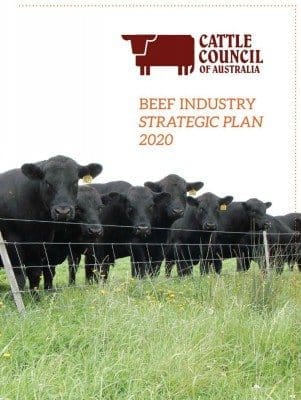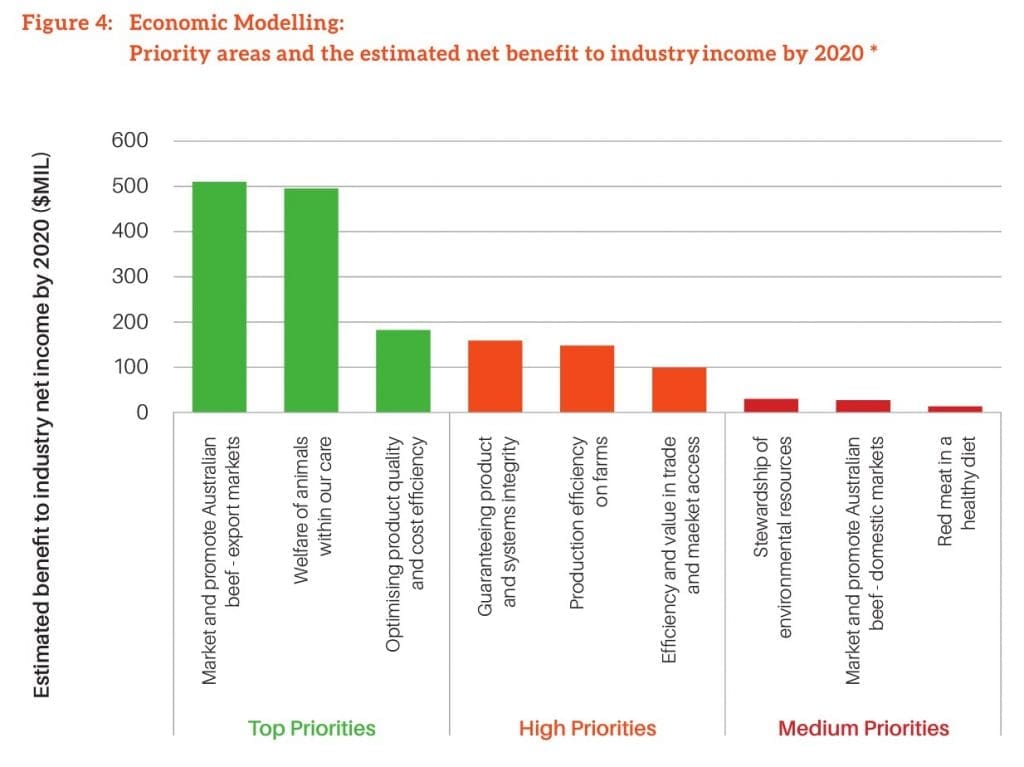 Where should the finite resources of the Australian grassfed cattle industry be spent to generate the highest benefits?
Where should the finite resources of the Australian grassfed cattle industry be spent to generate the highest benefits?
A comprehensive new strategy document released by Cattle Council of Australia today details where the industry believes it can get the best bang for its levy-funded bucks in the next five years.
The Grassfed Beef Industry Strategic Plan 2020 (BISP 2020) draws on the results of consultation with grassfed levy payers and industry stakeholders and economic modeling and analysis.
It is, in effect, the beef industry’s response to the wider Meat Industry Strategic Plan 2020 (MISP 2010), released by RMAC last year.
BISP 2020 will help to guide the resources of Cattle Council of Australia and the levy-funded industry service organisations Meat & Livestock Australia, Animal Health Australia and the National Residue Service for the next five years.
The new strategy is founded on the premise that the grassfed beef industry has a bright future, but opportunities will not simply happen. If Australia’s beef industry is strengthen its competitive position and improve the profitability of its participants, it must embrace change and innovation, and, more specifically, accelerate the move towards customer-focused value chains.
Accelerating the shift towards ‘value chain thinking’
Two phrases appear regularly in the document which capture the central focus of the industry’s plan: ‘fit-for-purpose’ beef production and ‘value based marketing’.
Encouraging the creation of more branded value-chains geared towards meeting precise consumer quality expectations and rewarding participating producers with premium returns is at the core of the industry’s five-year strategic plan.
CCA president Howard Smith says “value-chain thinking” is the key to the industry’s future.
“It means incorporating the needs of consumers at every step from the dinner plate through to the farm gate,” Mr Smith explains in the document.
“It will help increase transparency along the value chain, bring greater opportunities for producers to gain premiums and foster the collaboration we know is needed to drive our industry forward.”
Building on that focus, the plan identifies 10 priority areas for future investment (see chart below), including four “top priority” areas:
- Building industry capability (Developing skills and leaders and improving industry structures and service organisations);
- Improving animal welfare;
- Marketing and promoting Australian beef into export markets; and
- Optimising product quality and cost efficiency.
So what will success look like?
If the plan achieves its aims, outcomes by 2020 should include (more detail on expected outcomes in full document):
- A greater number of skilled industry leaders;
- More beef being sold through customer-focused, collaborative value chains, where the benefits are shared by all participating businesses in the value chain;
- More Australian beef exports differentiated from competitor products to maximise returns and attract premiums;
- More flourishing commercial brands;
- An increased number of producers aligned with branded beef product programs;
- More flexible and accountable industry representative bodies, that are more focused on a few high priority issues rather than spreading efforts thinly;
- A new national cattle producer’s body in place;
- Maintained and improved consumer and community confidence in Australian beef and its production practices;
- Agreed animal welfare indicators in place and monitored;
- Evidence of improving industry performance against a baseline for environmental and natural resource management issues;
- Improved trade and technical market access;
- Premiums being paid by domestic consumers for beef products relative to competing proteins;
- Widespread application of existing R&D knowledge;
- Productivity gains concentrated in areas that improve efficiency and producer profitability, not driven by a strategy of competing on a lowest cost-basis;
- More producers receiving timely, reliable signals from the value chain that reflect real value differences for their cattle, based on objective measures of preferred attributes;
- Improved beef language specification that aligns with end user requirements in place; and
- Reliable information flowing rapidly up and down the value chain,
Scorecards for CCA and MLA
The document identifies several Key Performance Indicators (KPI) to measure progress.
One of the first tasks the document recommends is early investment to establish baselines so the industry’s progress on each KPI can be measured and its performance evaluated over time.
As part of this process, the document suggests that the MLA and CCA should provide a BISP2020 scorecard at their annual general meetings for the next five years, showing the extent to which resources and efforts have been allocated towards each priority area and the progress made.
Industry must ‘refocus’ its efforts
Mr Smith said the plan outlines a vision to “refocus” industry efforts and resources to strengthen Australia’s competitive position as a trusted source of premium quality products.
He said it will require a fundamental shift in mindset and practices by industry businesses towards value chains – or, incorporating the needs of consumers from paddock to plate.
The plan reveals an expected benefit of $389 million to industry net income by 2020 in developing export markets alone.
A key aim is to increase on-farm production efficiency by 0.5 per cent in northern Australia and 1.75 per cent in southern Australia by 2020 through new research.
“With the success of the strategy dependent on strong leadership and collaboration across the value chain, Cattle Council has positioned itself to be on the front foot and lead by example.
“We are committed to play a leading role in this process,’’ Mr Smith said.
To access the Grassfed Beef Industry Strategic Plan 2020, visit http://e-doc.me/cattlecouncil1




Friday was the closing day for public submissions to the draft Australian beef language white paper, standards are another issue. There are those that believe that language reform will be critical to moving towards Value Based Marketing, which is a key component of both the BISP and the MISP. This industry needs to change its business model, we are not a low cost of production supplier to the global beef trade. The Australian beef industry has long been highly regarded for its standards and protocols, there is now more competition in the “safe,clean and green” marketing space, there is wide belief that looking to differentiate our product on a quality basis and seek price differentiation on such a basis is possibly the best way to increase returns at each point in the value chain. Surely no one would argue that if historical returns on investment of around 3% at the processing sector and the equivalent in the production sector putting you in the top 5% are not sustainable in today’s business world. Having myself been part of a submission to the draft, I understand the frustration of the re-visioning process, I have taken the view that we have had a chance to have input into the vision for a new Australian beef language, I hope those that are critical of the process have themselves put submissions in, after all this is just the start of the process to change. I believe for there to be any chance of the KPI’s in the BISP being met, language reform as part of a move to VBM will be essential.
Michael Craig, there is no cynicism or conspiracy theory. The AFI has been commissioned by RMAC as reported by Beef Central, to put forward suggestions on how a new cattle advocacy organisation might be funded
On the table no doubt will be sponsorship and commercial opportunities. One of those opportunities will likely be ahditing services for a whole plethora of market requirements as outline in the Beef Language and Standards Review also linked in an article in Beef Central.
What is cynical is that CCA has announced its plan for “value chain thinking” and “consumer focus” ahead ofthe close of public submissionsto the Language and Standards Paper due Friday.
Obviously public submissions by people who have an opinion to share are not to be listened to.
There are a number of unexploded bombs in the proposed system and a number of historical problems which need to be focused on to protect producer interests at auditing, its procedures and defaults before our advocacy body leads us down the path of more auditing. It also needs to look at limiting our liability under LPA where no negligence has occured before exposing us and all of our openly shared data to a global UN controlled system.
The resources companies with whom many of us are forced to co-exist make sure that they limit liability and some of that liability has been transferred to cattle producers.There needs to be some default regulation built into the system but our cattle bodies have failed to do what resources companies do as a matter of course.
The value chain marketing and implied premiums will come at great cost to affected producers, their privacy and ownership of data and sovereignty of the Australian industry over systems governing our product.
If you think I am being a conspiracy theorist go to the Beef Language and Standards White Paper and read it in its entirety with open eyes about future effects.
David, my understanding was 1000s of farmers were consulted, I wasn’t one of them, but it is interesting they have just discovered customer requirements as being important. What I want to see is the detail of how much this is this going to improve farmer incomes? Unexplained and unexplainable but they are using our levy money and if recent history is any guide it wont do a blind bit of difference to farm returns per animal.
The old chestnuts of cynicism and conspiracy theory coming from David Byard.
It reflects a bulk commodity thinking which just focuses on costs, which will then struggle with the value chain concept.
It’s not rocket science, it’s about putting the consumer first and ensuring value is distributed equitable and transparently within the chain which can then incentivise value creating behaviour on farm. Instead we get this cynicism that CCA are trying to get a commission. The BISP makes logical sense for Australia’s market and producers have had an opportunity to comment through the Meat Industry Strategic Plan process. Instead we just get this conspiracy theory rubbish.
Would it be possible for CCA to explain to the cattle producers how much their ‘value chain’ is going to cost?
Secondly, with the ‘new’ initiatives how much commission does CCA expect to get if the proposals are adopted?
Thirdly, will all producers who have a statutory levy deducted of the cattle transaction have any say over the ‘new’ initiatives?